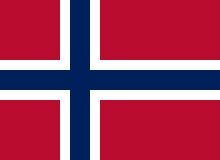Norwegian possessions
The Kingdom of Norway owned some areas outside of its continental territory until 1814, but these cannot be called colonies. They were only dependent on Norway.
Since the exploration of the polar regions , some islands in these regions belong to Norway - partly as dependent areas, partly as national territory.
Medieval Norway
- The Faroe Islands were settled by Norwegians around 885–890 under the leadership of Harald Fairhair . From 1035 the archipelago belonged politically to Norway. Because of the great distance, the Faroe Islands were able to retain parts of their independence. With Queen Margarethe I of Denmark , Denmark and Norway were united and the Faroe Islands fell under the Danish-Norwegian crown. When Norway was lost in 1814, the Faroe Islands finally came under Danish rule.
- Shetland and the Orkneys belonged to Norway until 1469, during which time they were directly subordinated to the Norwegian Crown, and since then they have been incorporated into Scotland .
- Iceland was settled from Norway from the 9th century. In 1262 Iceland came under Norwegian rule. The island also remained with Denmark in 1814.
- Greenland was discovered by Norwegians around 875 and the island was settled around 982. Contact broke off for 300 years until Denmark-Norway occupied the island in 1721. The rule lasted until 1814, when Greenland also fell to Denmark.
- The Vikings had been raiding and occupied land in England since 793. A kingdom of Norwegian Normans existed around York until 954, a last Norwegian attempt at conquest failed in 1066 in the Battle of Stamford Bridge .
British Isles possessions :
- Kingdom of York , with it Northern England, lost in 1066
- Kingdom of Dublin , lost to Battle of Clontarf in 1014
- Isle of Man and Hebrides , ceded by Peace of Perth in 1266
America:
Danish-Norwegian personal union
When Norway was linked to Denmark by the union, both states had the following colonies (which can also be called such):
- Danish West Indies 1666-1814 to Denmark-Norway, until 1917 to Denmark
- Nicobars as Ny Danmark 1756-1814 to Denmark-Norway, until 1868 to Denmark
- Trankebar 1620-1814 to Denmark-Norway, until 1845 to Denmark
- On the gold coast of West Africa, Denmark-Norway had various bases and fortresses in the 17th and 18th centuries, which were known as the Danish Gold Coast .
See also: Danish colonies
Today's overseas territories and territorial claims in the Arctic and Antarctic
Dependent areas
- Bouvet Island , dependent territory on Great Britain in 1930 and not part of the Kingdom of Norway
- Jan Mayen 1930 part of Norway, but does not belong to any Norwegian province
- Svalbard , part of Norway through the Svalbard Treaty in 1925 , does not belong to any Norwegian province
Today's claims
- Peter I Island 1930, not recognized internationally by the Antarctic Treaty .
- Queen Maud Land 1939, not recognized internationally by the Antarctic Treaty .
Claims abandoned
- In 1868 Nils Fredrik Rönnebeck measured some islands of the Franz-Josef-Land and took it under the name Rönnebecks Land for Norway. On April 15, 1926, the Soviet Union declared Franz Josef Land to be Soviet territory amid Norwegian protests.
- Sverdrup Islands : The Norwegian Otto Sverdrup explored and mapped the Sverdrup Islands from 1898 to 1902, and took possession of them for Norway. In 1930 a treaty was signed between Norway and Canada. As part of this treaty, Norway relinquished its territorial claims on the Sverdrup Islands.
- Eirik Raudes Land and Fridtjof-Nansen-Land in East Greenland: When Denmark closed East Greenland to non-Danes in 1930, a Norwegian protest rose. Norwegians occupied the so-called Eirik Raudes Land in northern East Greenland, with reference to the fact that Denmark could only make claims in West Greenland, which is actually Danish-controlled. In 1932, the so-called Fridtjof-Nansen-Land was occupied in southern East Greenland. The Norwegian occupation of East Greenland lasted until 1933, when the Hague Court of Arbitration awarded the whole of Greenland to Denmark.



